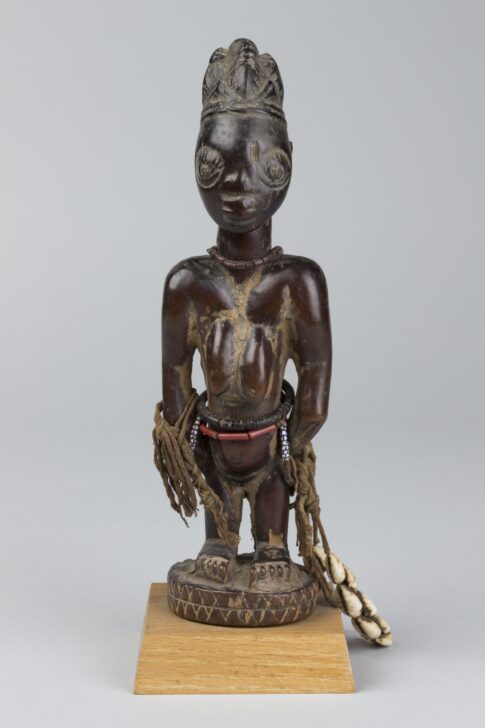Female Twin Figure
Yoruba

Description
Subject Matter:
Up until the 1980s, Ere ibeji were small figures used by Yoruba peoples in the worship of twins. This practice has largely been replaced by portraits and plastic dolls.
Twins are thought to be two bodies sharing one soul, so to placate, as well as embody the spirit (emi), a figure (ere) would be carved to represent a deceased twin (ibeji). Yoruba peoples have the highest rate of twins per birth in the world, and in the past, high infant mortality meant many twin figures were carved. The ere ibeji was treated as a living person, regularly fed, washed, clothed, and carried. As a center of this ritual activity, these twin figures transformed from a memorial to an embodiment of the deceased twin that allowed them to be present to the living.
In addition to housing the spirit of a deceased twin, ere ibeji also represented the Yoruba ideal of good character. Part of what constitutes good character is a sense of composure or ‘coolness’, called itutu. Many aspects of ere ibeji embody this sense of ‘coolness:’ The calm face with serious, sealed lips and a poised stance with hands at the sides is a position of spiritual alertness that reflects ‘coolness’ and thus, good character. After being carved, the head of the twin figure would be rubbed with an indigo dyed cloth and some hairstyles/headgear were painted with blue pigment, as blue is the color of ‘coolness’.
Twins are also associated with Shango, the Yoruba orisa (or god) of thunder, and the protector of ibeji, as twins are called “children of thunder.” Some aspects of ere ibeji reference Shango, such as the rubbing of the twin figure with red camwood powder, as Shango is associated with the color red, and plaited hairstyles, as Shango is often depicted with plaited hair. The beads around the neck and waist of this ere ibeji may represent various orisas (gods) or ancestors worshipped by the family, whose lineage or place of origin may be referenced in the facial marks of the figure. The brass bracelets may refer to the orisa Osun, the goddess of beauty and maternal wealth.
References:
Drewal, Henry, Yoruba: Nine Centuries of African Art and Thought, 1989
Doris, David, Yoruba Images and Aesthetics, 2004
Micheli, Angelo, Doubles and Twins in African Arts, Spring 2008
Nicklin, Keith, Yoruba: A Celebration of African Art, 1991
Thompson, Robert Farris, Flash of the Spirit, 1983
Physical Description:
Standing female figure with hands at sides on a round base, which is mounted on a square base. There are strings of beads around the waist, wrists, and neck. Around one wrist is a string of cowrie shells. The pupils of the eyes are metal and the hair is in a tri-lobe shape with patterns of geometric lines. This object has a patina along the creases.
Usage Rights:
If you are interested in using an image for a publication, please visit https://umma.umich.edu/request-image/ for more information and to fill out the online Image Rights and Reproductions Request Form.